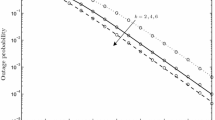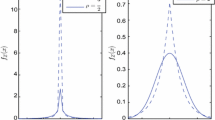Abstract
A simple procedure is outlined to provide a point estimate mixture gamma distribution (PEMG) which closely approximates intractable distribution characterizing composite fading channel. The efficacy of the proposed PEMG to match target channel model in relation to other available approximate distributions is demonstrated using Kullback–Leibler measure of divergence. The simplicity and accuracy of the PEMG facilitates the computation of analytical expressions for some of the widely used performance measures viz., average symbol error rate and channel capacity under different adaptive transmission schemes. Numerical computations in relation to exact results are carried out to validate the accuracy of the derived expressions over the realistic range of parameters for the channel model.







Similar content being viewed by others
References
Suzuki, H. (1977). A statistical model for urban radio propogation. IEEE Transactions on Communications, 25(7), 673–680.
Hansen, F., & Meno, F. I. (1997). Mobile fading-Rayleigh and lognormal superimposed. IEEE Transactions on Vehicular Technology, 26(4), 332–335.
Simon, M. K., & Alouni, M. S. (2000). Digital communication over fading channels : A unified approach to performance analysis. New York: Wiley.
Loo, C. (1985). A statistical model for a land mobile satellite link. IEEE Transactions on Vehicular Technology, 34, 122–127.
Abdi, A., Lau, W. C., Alouini, M. S., & Kaveh, M. (2003). A new simple model for land mobile satellite channels: First- and second-order statistics. IEEE Transactions on Wireless Communication, 2, 519–528.
Abdi, A., & Kaveh, M. (1998). K distribution: An appropriate substitute for Rayleigh-lognormal distribution in fading shadowing wireless channels. Electronics Letters, 34(9), 851–852.
Karmeshu, & Agarwal, R. (2007). On efficacy of Rayleigh-inverse Gaussian distribution over K-distribution for wireless fading channels. Wireless Communications and Mobile Computing, 7(1), 1–7.
Laourine, A., Alouini, M. S., Affes, S., & Stphenne, A. (2009). On the performance analysis of composite multipath/shadowing channels using the G-distribution. IEEE Transactions on Communications, 57(4), 1162–1170.
Bithas, P. S. (2009). Weibull–gamma composite distribution: Alternative multipath/shadowing fading model. IEEE Electronics Letters, 45(14), 749–751.
Al-Ahmadi, S., & Yanikomeroglu, H. (2010). On the approximation of the generalized-K distribution by a gamma distribution for modeling composite fading channels. IEEE Transactions on Wireless Communications, 9(2), 706–71.
Atapattu, S., & Tellambura, C. (2011). A mixture gamma distribution to model the SNR of wireless channels. IEEE Transactions on Wireless Communications, 10(12), 4193–4203.
Abdi, A., & Kaveh, M. (2000). Comparison of DPSK and MSK bit error rates for K and Rayleigh-lognormal fading distribution. IEEE Communications Letters, 4(4), 122–124.
Bithas, P. S., Sagias, N. C., Mathiopoulos, P. T., Karagiannidis, G. K., & Rontogiannis, A. A. (2006). On the performance analysis of digital communications over generalized-K fading channels. IEEE Communications Letters, 5(10), 353–355.
Laourine, A., Alouini, M. S., Affes, S., & Stphenne, A. (2008). On the capacity of generalized-K fading channels. IEEE Transactions on Wireless Communications, 4(11), 2441–2445.
Bithas, P. S., Sagias, N. C., Mathiopoulos, P. T., & Kotsopoulos, S. A. (2007). Diversity reception over generalized-K (KG) fading channels. IEEE Transactions on Wireless Communications, 6(12), 4238–4243.
Efthymoglou, G. P., Ermolova, N. Y., & Aalo, V. A. (2010). Channel capacity and average error rates in generalised-K fading channels. IET Communications, 4(11), 1364–1372.
Zhou, J., & Nowak, A. S. (1998). Integration formulas to evaluate functions of random variables. Journal of Structural Safety, Elsevier, 5, 267–284.
Zhao, Y. G., & Ono, T. (2000). New point estimates for probability moments. Journal of Engineering Mechanics, 126(4), 433–436.
Shankar, P. M. (2011). Fading and shadowing in wireless systems. New York: Springer.
Rosenblueth, E. (1975). Point estimates for probability moments. Proceedings of the National Academy of Sciences USA, 72(10), 3812–3814.
Adebola, E., Olabiyi, O., & Annamalai, A. (2013). On the Dirac delta approximation and the MGF method for ASER analyses of digital communications over fading channel. IEEE Communications Letters, 17(2), 245–248.
Goldsmith, A. (2006). Wireless communications. Cambridge: Cambridge University Press.
Olabiyi, O., & Annamalai, A. (2012). Invertible exponential-type approximations for the Gaussian probability integral Q(x) with applications. IEEE Wireless Communications Letters, 1(5), 544–547.
Goldsmith, A., & Varaiya, P. (1997). Capacity of fading channels with channel side information. IEEE Transaction on Information Theory, 43(6), 1986–1992.
Alouni, M. S., & Goldsmith, A. (1999). Capacity of Rayleigh fading channels under different adaptive transmission and diversity combining techniques. IEEE Transactions on Vehicular Technology, 48(4), 1165–1181.
Wolfram. The Wolfram functions site. http://functions.wolfram.com.
Acknowledgments
The authors would like to thank the reviewers for useful comments which have improved the presentation of the paper.
Author information
Authors and Affiliations
Corresponding author
Rights and permissions
About this article
Cite this article
Khandelwal, V., Karmeshu Performance Analysis of Composite Fading Channel Based on Point Estimate Method. Wireless Pers Commun 79, 953–968 (2014). https://doi.org/10.1007/s11277-014-1897-6
Published:
Issue Date:
DOI: https://doi.org/10.1007/s11277-014-1897-6




